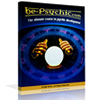REAL Examples of Time Travel
April 22, 2009 by Quantum Publisher
Filed under Mind Stretch
 In August 1901, two Oxford professors, Anne Moberly and Eleanor Jourdain, were walking through the gardens of the Palace of Versailles when they noticed a shimmering effect on the landscape. When the shimmering had passed, the women noticed that they seemed to have been transported back in time to about a hundred years earlier.
In August 1901, two Oxford professors, Anne Moberly and Eleanor Jourdain, were walking through the gardens of the Palace of Versailles when they noticed a shimmering effect on the landscape. When the shimmering had passed, the women noticed that they seemed to have been transported back in time to about a hundred years earlier.
The people around them wore 18th century clothes and wigs, and were behaving in a very agitated manner. Eventually the vision faded, and the two women found themselves back in 1901. Â Shocked at what they had experienced, they carried out some research and concluded that they had somehow witnessed the sacking of the Tuleries and the massacre of the French Guards during the French revolution in 1789.
So… can the veil between past and present be momentarily lifted? Would this also explain why some people say they can hear battle sounds at historic battle sites? Â
What about Einstein’s theories?
Einstein’s theory of relativity tells us that both distance and time are not absolute, but are affected by an object’s motion. This makes time relative. So if we could construct a spacecraft faster than the speed of light, in theory we could travel through time.
Physicist Kurt Gödel proposed an ingenious solution to Einstein’s theorems that allows for time travel. He proposed that timelines close back on themselves such a way that the distant past and the distant future became one in the same — creating whirlpools in which time wraps itself into a circle. Anyone moving along in the same direction of rotation of the whirlpool could find themselves back at the starting point, but backwards in time.
Does the answer lie in wormholes?
So… can we travel through time using wormholes? This is an idea that is being given serious consideration by some scientists. One hypothesis is that a wormhole could be a shortcut between two points – linking different areas of the fabric of time and space. Â But can we time travel through wormholes?
The Philadelphia Experiment
And then… did the US Navy attempt time travel using a secret Tesla technology and one of their ships, and did the first experiment go terribly wrong?
Two experiments were conducted exactly forty years apart in August 1943 and August 1983. Â During the 1943 experiment the US Eldridge was said to have disappeared completely for twenty minutes. This left a great number of people convinced that the Navy succeeded. Forty years later the experiment was attempted again, perhaps to correct what had gone wrong with the Philadelphia experiment.
Many researchers and scientific types have tried to unravel the Philadelphia Experiment. The US navy denies it ever happened, and has classified all reports around the experiment as Top Secret. Was it time travel? Was it high tech? Was it all a hoax?
Transcending time in the mind
From a metaphysical point of view, time travel is not necessarily a physical endeavor.
In Yogic practices, mystics are said to be able to practice a range of miraculous feats such as bilocation, and casting energy forward or backward through time. Perhaps non-physical energy like thoughts can transcend time. It could be possible that the past, present and future do exist as one, and that some people are able to tap into the universal mind and see the future.
One thing is certain: The more scientists learn about the nature of reality, the more *slippery* the coments of past, present and future — or here or there — become. There’s other speculation that just thinking about the future is time projection. What do YOU think?
 SCIENTIFIC PROOF YOU ARE PSYCHIC
SCIENTIFIC PROOF YOU ARE PSYCHIC
Have you ever wondered if you are psychic, or perhaps have special powers of telepathy or precognition? YOU DO! Come explore how to develop your natural, scientifically-proven mental powers. MORE INFO.
Lie Down to Be More Creative?
April 21, 2009 by Quantum Publisher
Filed under Creativity
 It seems we can be smarter and more creative lying down than standing up says one researcher.
It seems we can be smarter and more creative lying down than standing up says one researcher.
Dr Darren Lipnicki at the Australian National University (ANU) school of psychology found that people solve anagrams more quickly when lying on their backs than standing on their feet.
Lipnicki tested 20 people who were asked to solve 32 five-letter anagrams while standing, and while lying down. He found that the anagrams were solved more quickly lying down than standing up. The researcher said his subjects reported that while lying down, the solution just *popped into their minds* similar to the aha or Eureka experience associated with major innovative creative breakthroughs.
Lipnicki feels the results are due to the difference in brain chemistry when lying down vs standing up, and specifically to the release of the neurotransmitter noradrenaline. While noradrenaline is normally associated with cognitive ability and focused attention, it is also believed to impair creative thinking. And significantly less noradrenaline is released while lying down.
Archimedes and the ancient reclining poets
Lipnicki concluded that creative thinking might also be facilitated when lying down. He says there is historical evidence for this in the case of the Greek mathematician Archimedes, who concluded while lying in his bath that the amount of water that overflowed his tub was proportional to the amount of his body that was submerged.
The observation became known as Archimedes’ principle — the principle that an object immersed in a fluid experiences a buoyant force equal in magnitude to the force of gravity on the displaced fluid.
Professor of medieval history Donnchadh O’Corrain of University College Cork says medieval Irish poets also composed their complicated court poetry while lying flat on a couch in a darkened room. And there are descriptions dating back to 1571 of how law students studied by lying on flat straw pallets, he says.

The ULTIMATE GOAL ACHIEVEMENT SYSTEM.Personal goal-setting and achievement that works! Success and failure both start in the same place your mind. Overcome the #1 reason most people never achieve their goals. Clarify exactly what you want, and develop an action plan to get it. =>MORE INFO!
Experience Genius Level Creativity
April 21, 2009 by Quantum Publisher
Filed under Creativity
 Creativity is often viewed as a characteristic of a only few gifted geniuses.
Creativity is often viewed as a characteristic of a only few gifted geniuses.
John Briggs, the author of Fire In the Crucible: The Alchemy of Creative Genius agrees that the way we talk about creativity often reinforces the notion its some kind of special gift. But it’s not.
Truthfully — creativity goes far beyond the ability to paint, write, create a new business, invent a new product, or having a high IQ. When stripped down to its bare essentials, creativity is actually a fundamental survival skill.
Experience Genius CreativityÂ
On an artistic level … creativity is the search for the elusive Ah ha — a brief moment of insight when we suddenly see a problem, or an idea, in an entirely new and fresh way.
It’s true that not everyone can be Beethoven or Picasso or Einstein. But the impulse to breakthrough to a new idea is not limited to artists and geniuses. We each have our own natural creative genius.
But on the everyday level … creativity is actually at the heart of any action that somehow transforms your inner or outer reality. You are actually being creative when you open the refrigerator door and search for the makings of a sandwich.
Why So Few People Feel Creative
Why do so few people manage to consider themselves creative? It’s because most of us were taught to repress our natural desire to challenge the reality of things as they are. You can increase your creativity by simply adjusting how you think about creativity.
Professor Mark Runco, founder of the Creativity Research Journal explains it like this: We put children in groups and make them sit in desks and raise their hands before they talk. We put all the emphasis on conformity and order, then we wonder why they aren’t being spontaneous and creative.
Sound painfully familiar?
Overturning the Genius Myth
Another reason many do not consider themselves creative is the *I’m not a genius* syndrome — the sad assumption that genius level creativity requires a high IQ..
Actually your IQ has little to do with your creativity. David Perkins, co-director of Project Zero at the Harvard Graduate School of Education agrees. Perkins believes we don’t believe ourselves to be creative because we’re often intimidated by the genius myth.
This old myth claims creativity is restricted to high IQ geniuses. But this was actually debunked years ago in a study begun by Stanford psychologist Lewis Terman — the man who adapted the original French IQ test for the USA.
In the early 1920s Terman had California school-teachers select 1,528 “genius” schoolchildren with an IQ above 135. These children’s lives were then followed by a research team for 60 years. After six decades they found that these geniuses had done fairly well. Many were professionals and had stable, prosperous lives. But interestingly… very few had made notable creative contributions to society, and literally none had completed any extraordinary creative work.
According to Dr. Dean Simonton, author of Genius, Creativity and Leadership and Scientific Genius: There just isn’t any correlation between creativity and IQ.
Unleash Your Creative Impulses
To free your natural creative impulses it’s often necessary to resist the pressure to march in step with the rest of the world.
This can be admittedly tough. One place to start is by trying an original way of doing some habitual task. Virtually everything you do can be done in a slightly different, slightly better way … from organizing your paperwork, to washing the dishes. Remember, the essence of creativity is NOT necessarily getting things right. At it’s heart, creativity is based on risk taking. On being willing to make some mistakes.
And here’s a point about mistakes and failure: Many who claim they aren’t creative say this simply because they tried once, and failed. But interestingly, genius level creativity may actually go hand-in-hand with failure. Consider the great creative genius Edison. He held over 1,000 patents. But most of them are forgotten, because they weren’t worth much to begin with.
So don’t let fear of failure stop you from exercising and building your creative muscles.
Want to increase your creativity to genius level? Click here.


